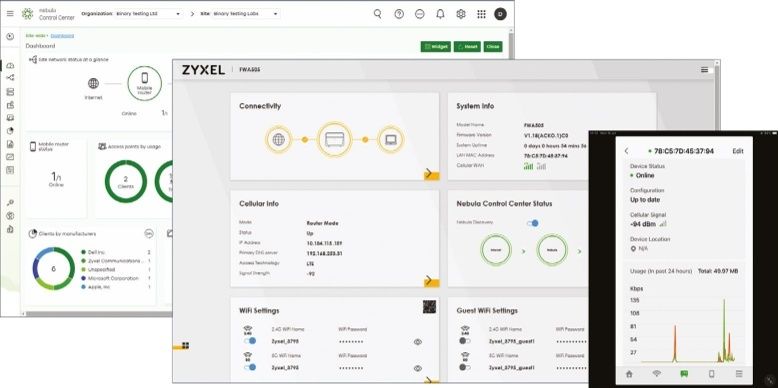This review first appeared in issue 361 of PC Pro.
Zyxel’s Nebula NFWA505 is designed to deliver wire-free internet access. This compact desktop Wi-Fi router teams up 5G with Wi-Fi 6 services and targets a wide audience including small businesses, SOHOs, mobile workers, pop-up stores and those that can’t get decent fixed-line broadband speeds.
The FWA505 replaces Zyxel’s older NR5101, but is more competitively priced and sees a design refresh, with all ports arranged vertically at the rear. The status LEDs have been moved from the base to the front of the unit and it also sports a pair of smaller TS-9 connectors at the back for optional external aerials.
Two gigabit ports are provided, with the first offering LAN or automatic WAN failover services and the second used for connecting other devices to its network. Its Wi-Fi 6 AP is AX1800-rated and delivers speeds of up to 1,200Mbits/sec on its 5GHZ radio and 573Mbits/sec on the 2.4GHz one.
As the model name indicates, the FWA505 can be cloud-managed from Zyxel’s Nebula Control Center (NCC), and the price includes a one-year Pro Pack license, with subsequent years costing around £28. You’ll need to familiarize yourself with its local web console, though, as unlike Zyxel’s fully compliant Nebula wireless APs and security routers, the FWA505 doesn’t broadcast cloud SSIDs and can only be configured from its own interface.
It’s easy enough to deploy as the web interface loads a wizard to get you started. Zyxel supplied our review unit with a Vodafone 5G SIM installed in the micro-SIM slot in the base, which provided instant cellular internet access.
The web console opens with a dashboard showing the status of local and internet connections, cellular status and details of wireless networks. A default SSID is provided for both radios and, although it uses the weaker WPA2 encryption, the encryption key is randomly generated and you can easily swap to the more secure WPA3.
Up to four SSIDs are supported, with three secure guest wireless networks already configured for you. These can be modified as required with the Guest WiFi tickbox enabling L2 isolation so users on these SSIDs only get internet access.
Network security is present and correct, with the router’s firewall offering three protection levels that can be quickly selected using a slider bar. Custom firewall rules comprising protocols, port numbers and ACL (access control list) entries can be created, while parental control profiles limit internet access to specific days and times and enforce URL and keyword blocking.
The gigabit WAN port can be used for internet access and teamed up with the mobile SIM for failover. We tested this by pulling the cable out and the router automatically swapped over to its 5G SIM in one minute.
The FWA505 also delivers respectable wireless speeds. Copies of a 25GB test file between a Windows 11 Pro workstation equipped with a TP-Link Archer TBE550E Wi-Fi 7 adapter and a server on the gigabit LAN averaged 107MB/sec at close range, dropping to 85MB/sec with the router ten meters away in an adjoining room.
Adding the FWA505 to our NCC account was simple as we scanned its QR code from an iPad running the Nebula iOS app. A mobile router status widget is added to the site dashboard and selecting it provides more hardware details, a location map and remote firmware upgrade services, plus views of WAN and cellular status and information about wired and wireless clients.
The NCC Pro Pack license increases traffic monitoring from 24 hours to 30 days but, more importantly, enables a remote configurator. Select this from the router’s Live Tools section and it will establish a secure HTTPS remote web console session so you can access all its settings.
Any small business and remote workers that want to go completely wireless will find the Zyxel Nebula FWA505 an affordable solution. It’s well designed, easy to use, delivers respectable wireless performance and can be remotely managed from Zyxel’s Nebula cloud portal.
We’ve listed the best Wi-Fi extenders.
Read the full article here














